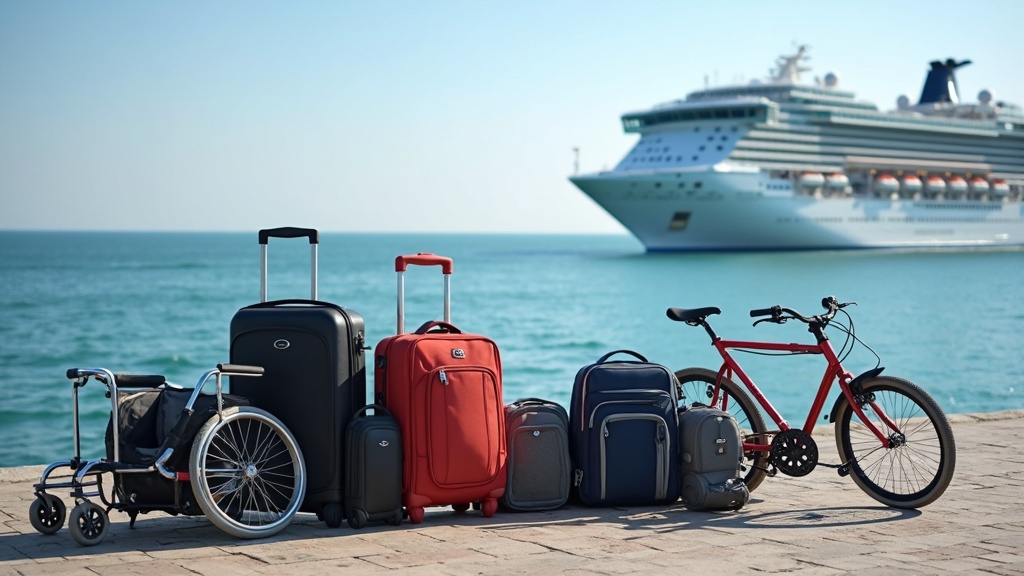Preparing for a cruise is always exciting, especially if it’s your first time or if you haven’t set sail recently. Packing for a seniorfriendly cruise needs a bit more thought than usual, though. Cruise lines have made progress with accessibility, but having the right gear and a few accessibility helpers can turn a good trip into a great one. Let me share some of my personal tips and break down the musthaves to help you enjoy a smooth, easy outing at sea.

Why Thoughtful Packing Makes Senior Cruises Smoother
Cruising is popular with seniors for a big reason: you get the chance to explore lots of places but only have to unpack once. From my experience, some smart pre-planning saves you a lot of headaches later. While cruise ships have become more accessible over time, being prepared is your best move for peace of mind. Trust me, your feet will thank you later.
Mobility aids, flexible luggage, and certain medical items all come in handy on board, during shore excursions, and when checking out port cities. Ask the cruise line what they offer, but remember, they can’t provide everything. If you use a walker, a wheelchair, or even just need supportive slip-on shoes, it’s up to you to make sure it’s on board with you from the start.
What’s Practically Required for Senior-Friendly Cruise Packing?
Packing for a cruise involves a little more than tossing in swimwear and sunscreen. Comfort, safety, and convenience are essential. Here are some everyday basics I always grab before heading out:
- Luggage on Wheels: Lightweight suitcases or duffel bags with spinner wheels lower strain on your arms and shoulders, especially when traveling long hallways or busy elevators.
- Medication Management: Pill organizers with large print labels and alarms help keep routines easy to follow, even with all the excitement on board.
- Compression Socks: These work wonders for long walks and excursions. They support circulation and can help prevent foot and leg swelling.
- Non-slip Shoes: A comfy, stable pair of shoes helps stop slips on pool decks and damp walkways.
- Refillable Water Bottle: Ships can get warm, and accessible routes can be longer than you think. Keeping hydrated with a sturdy, easy to hold water bottle pays off bigtime.
- Organizational Accessories: Hanging toiletry kits, magnetic hooks (because cruise cabin walls are often metal), and easy to open bags keep essentials right where you need them, not buried at the bottom of your bag.
Accessibility Gear That Makes Cruising Easier
Accessibility devices aren’t just for folks with mobility challenges—they’re a great idea if you tire out more quickly, are concerned about balance, or just appreciate convenience while traveling. Here are some handy solutions worth checking out if you want a low hassle cruise:
- Folding Mobility Scooters and Travel Wheelchairs: Lightweight versions work inside ships and on shore trips. Some cruise lines rent these, but bringing your own makes sure it’s the right fit for you.
- Portable Grab Bars: Suction bars can stick to smooth bathroom surfaces, giving you extra support in showers or on slippery parts of the ship.
- Seat Raisers: Small, travel seat risers or cushions help you get up from low chairs and theater seats, as well as lounge areas up on deck.
- Shower Chairs: If standing for a while isn’t comfortable, bring a collapsible shower chair. Most cruise lines can supply one if you ask early, and there are plenty of light, travel ready versions online.
- Reachers and Long Handled Shoe Horns: These tools make it easy to grab things from shelves or pull on your shoes without too much bending.
Packing Tips: Staying Organized and Safe On Board
I’ve found that keeping your belongings organized makes everything less stressful while cruising, which matters even more when accessibility is on your mind. Try these tricks for an easier adventure:
- Use Packing Cubes: Assign cubes for different types of items: clothing, medical gear, and your daily care tools. This makes finding what you need—and repacking—fast and simple.
- Bring Medical Records: Have digital or paper copies of your prescriptions, doctor contacts, and important health info, such as allergies or medical devices. It can help if there’s any emergency.
- Consider a Travel Medical Alert: Wear a medic alert bracelet or keep digital health info on your phone or a wearable tag. That way emergency help can find your details quickly if something unexpected happens.
- Personal Safety Gear: Toss a small flashlight and a nightlight into your bag. A basic door alarm can also help, giving you peace of mind while you move around onboard at night.
Accessibility on Cruise Ships: What to Know Before You Go
Cruise lines generally do a pretty good job, but each one is different in how accessible their ships are. Doing your homework before booking goes a long way. Here are some important things to check out:
- Cabin Accessibility: Look for cabins with wider doors, roll-in showers, grab bars, and stepless entries. Let the cruise line know your needs before booking to get a truly accessible room.
- On-Board Routes: Make sure there are accessible walkways to restaurants, buffets, theaters, and pools. Some ships have tricky ramps or decks, so reading reviews and seeing photos gives you useful insights.
- Accessible Excursions: Not all shore trips are friendly to those with mobility aids. Ask about bus lifts, step-free sightseeing, and if the port uses tenders—these are small boats that can make getting to shore a bit tougher.
- Onboard Wheelchair/Scooter Rentals: Reserve these early. Rental stock is limited and can go fast during busy travel periods.
Overcoming Common Cruise Challenges for Seniors
Cruising can bring up some unique challenges. Here are a few common hiccups, along with my go-to solutions:
- Unsteady Ground: Even the biggest ships can move. Using handrails, walking sticks, and sturdy shoes helps keep you balanced during rougher seas.
- Long Distances: Extra-large ships can mean a lot of walking. Try scooters or book a crew-assisted ride so you have more energy for the fun stuff.
- Accessible Dining: Buffets are hard to manage if you use a mobility aid or have diet restrictions. Crew help or opting for sittable dining venues makes meals a breeze.
- Restroom Locations: Request a cabin near elevators or accessible restrooms. You’ll thank yourself later for shorter bathroom breaks.
- Shore Tendering: Plan ahead if your port uses tenders instead of docking. Ship crews will help, but it is harder for wheelchair users or people dealing with balance issues.
Packing for Varying Weather & Activities
Layering clothes is the way to go. Cabins and public spaces can vary in temperature, and shore stops might be warmer, breezier, or unexpectedly cool. Pack a light rain jacket, sun hat, scarf, and an extra cardigan or two. Swimwear and a travel poncho are handy for both pool days and surprise showers.
Travel Insurance and Emergency Prep
Don’t skip travel insurance—it’s key, especially for seniors and anyone with health concerns. I keep photocopies of insurance cards and emergency contacts in a pouch away from my main bag. Doublecheck your coverage so you know it includes mobility aids and replacement medications just in case your luggage goes missing.
Real Life Scenarios: What to Expect as a Senior Cruiser
Someone I know uses a travel rollator (a walker with a seat), and it made exploring ports and waiting in buffet lines much easier. The one drawback was the tight cabin space, but with an overdoor organizer, she kept essentials in easy reach. Another friend always brings his lightweight scooter and books excursions labeled as “wheelchair accessible.” These tours book up quickly, so reserve them early for the best choices.
These stories match what shows up in travel forums. Smart packing, checking things out ahead, and a few clever tools lead to a much more enjoyable cruise, with less fuss along the way.
Frequently Asked Questions
Here are several common questions from seniors or travelers with accessibility needs heading on a cruise:
Are portable oxygen concentrators allowed on cruise ships?
Answer: Most cruise lines allow portable oxygen, but you should notify them ahead of time and bring adequate supplies. Sometimes you’ll need to arrange specific equipment or extra batteries, too.
Can I rent a wheelchair, walker, or scooter on board?
Answer: Many large cruise lines offer rentals for mobility aids, but available inventory is limited. Reserving some time in advance will secure the equipment you need.
What if I have a food allergy or medical dietary requirement?
Answer: Note any dietary needs when booking, and bring it up again at check-in. Dining staff are usually well informed and can prepare safe meals, but it’s always good to doublecheck if you have severe allergies.
Will my CPAP or other medical device work with the ship’s power outlets?
Answer: Most modern ships use 110V/220V outlets; a compact power strip (without surge protection) and an extension cord will solve most problems. Check in with the line if you have any special needs.
Final Suggestions for Senior-Friendly Cruising
For a positive cruise experience with accessibility in mind, it all comes down to prep, picking the right setup, and checking in with your cruise provider in advance. Simple fixes—like having your mobility aid and booking an accessible cabin—make a huge difference in overall comfort and fun throughout the trip.
I hope these ideas help you set out on a safe and easygoing adventure that suits your needs and pace. Have fun on the open sea, and may your next cruise be full of great moments from start to finish.
